Now that you’ve had your fill of chocolate and Easter treats – now that you’re jelly-beaned out – it’s time for some embroidery treats!
I promise you, these embroidery goodies from around the web beat chocolate and jelly beans hands-down, any day of the week and ten times on Tuesdays!
Ready?
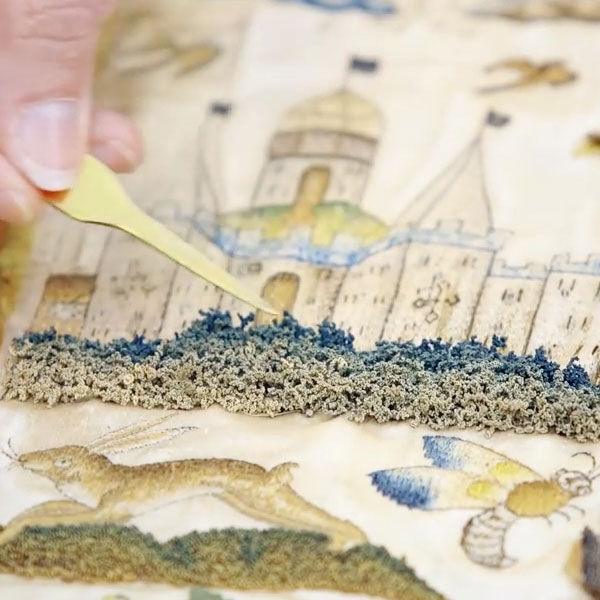
17th Century Embroidery – Alison Cole
First up, whether you’re into 17th century embroidery or not, this will delight you!
NGV Melbourne has recently produced a wonderful video of Alison Cole examining and explaining a 17th century embroidery piece. The video is short, but clear and instructive. Not only do you get to see elements of the embroidered panel up close, but, in a short space of time, you get very clear instructions on three unique 17th century embroidery techniques.
In the photo above, for example, see the mossy area in front of the castle?
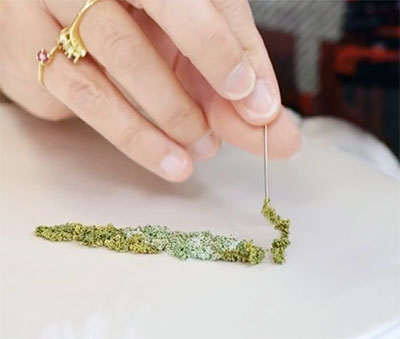
In the video, Alison shows us how this type of squiggly moss was created on these pieces. Absolutely fascinating!
She also demonstrates how to create a uniform, velvet-like pile filling and detached elements (stumpwork) involving a needlelace filling and pearl purl.
The beautiful embroidered panel and all three techniques are definitely worth seeing. And don’t worry – even if recreating 17th century embroideries is not your thing, the techniques are perfectly transferrable to contemporary embroidery.
Here’s the video:
If you’re reading this via the Needle ‘n Thread daily newsletter, visit 17th Century Embroidery, Needlepainting, Nibbles & More to view.
Isn’t it fantastic? I’ve watched in at least a dozen times. I’m planning on trying a couple of them out myself on a current piece I’m working on. Can’t wait!
New Thistle Threads Needlework Nibble
Speaking of 17th century embroidery, in case you don’t know it yet, Thistle Threads has a brand-new web shop up and running.
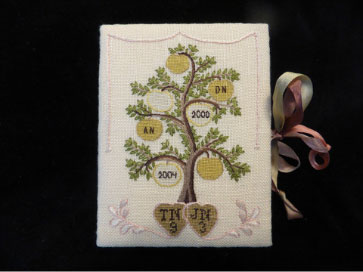
And on that website is a new Needlework Nibble – this Middlesex Tree Sampler, which makes up into a little needlebook and scissor case.
Tricia’s Needlework Nibbles are small projects for “tasting” a certain type of stitching technique – or, in this case, a finishing technique. As with the Nibbles available in the past, part of the proceeds go towards the support of various museums, textile collections, and the like. For this particular Nibble, a portion of the proceeds go towards the conservation of some new tree samplers acquired by the Lexington Historical Society.
This Nibble includes all the finishing materials (checked silk, ultra suede, ribbons, and doctors flannel) for the needle and scissors book. It doesn’t include printed instructions (the instructions for the Middlesex Tree Nibble can be download for free here) or threads and linens.
Tricia’s Needlework Nibbles are a terrific way to sample a finishing or stitching technique while helping a good cause!
A Little Spring Needle Painting?
Ahhhh – Spring! Here in the States, I know some of us are still waiting for it to arrive for real!
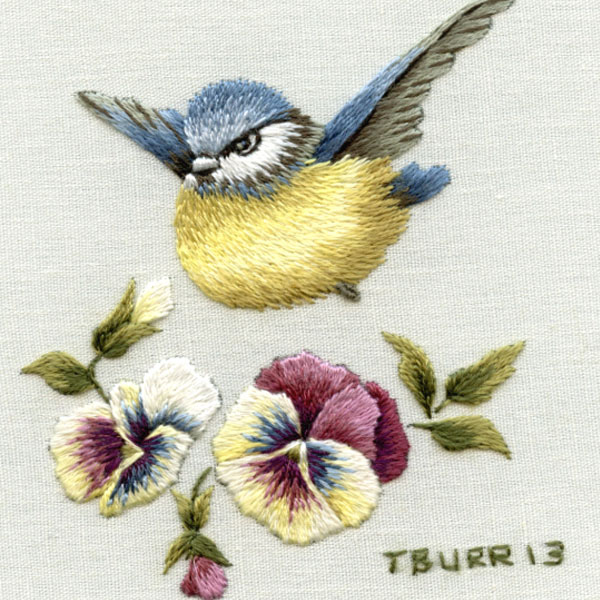
If you want to get some spring stitching in, and if you’re dying to try some needle painting, then head over to Trish Burr’s blog for this magnificent little needle painting freebie!
The Bluetit & Pansies design includes a materials list, the pattern, and instructions for embroidering this darling little bird in flight over a cluster of pansies.
It’s lovely – thanks, Trish!
Using Line Stitches for Fillings
Over on Craftsy, I’ve published a few articles lately. Check them out:
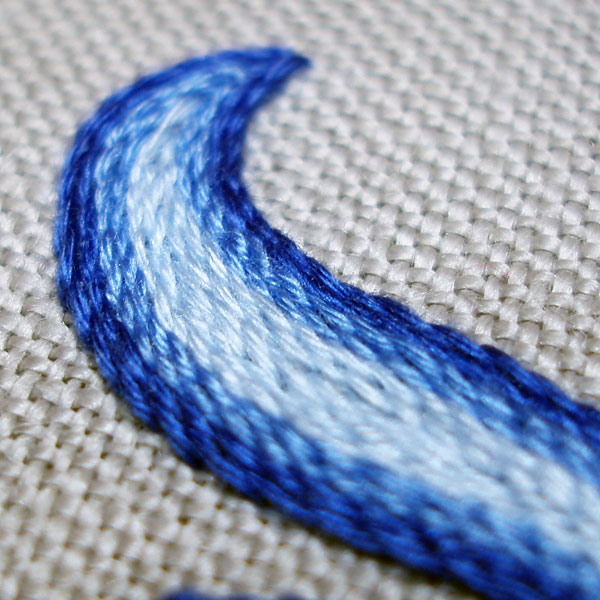
Filling in the Lines: Using Line Stitches for Embroidered Fillings discusses how a variety of line stitches can be used to fill large spaces in embroidery.
Another recent article: Let Your Imagination Fly with Hand Embroidered Feathers, which discusses different ways of embroidering – you guessed it! – feathers.
I have a few more articles soon to be published over there, too – one on working hand embroidered samplers with a variety of surface stitches among them. And in the not-so-distant future, I’ll be demonstrating embroidered handwriting and making embroidered bookmarks. I’ll let you know when those are out!
Coming Up on Needle ‘n Thread
Oh, I’ve got a couple Stitch Fun tutorials coming up! I love working up tutorials for obscure stitch variations and sharing them in the Stitch Fun! series. If you haven’t checked out the Stitch Fun Index lately, it’s growing and growing and growing. I’m juggling ideas on how to make that a visual index for you. But in the meantime, you’ll find links to over 70 stitch fun tutorials listed on the index.
Tomorrow, we’ll chat a bit about printing on fabric again. And later in the week, we’ll look at some project development.
Have a terrific Tuesday!







Aaah …. I always wondered about this squiggly stitching I ,ve seen on these 17th century embroideries . Thanks for such interesting research .
Wow, thanks for sharing! I’m so fond of historical embroidery.
Sorry to speak off-topic, but I have a question about Millennium frame – I would so much appreciate if you or your readers could help me! I finally got my frame after waiting for 15 weeks and receiving no replies for my emails. Their lack of communication put me in rather negative spirit.
Now I got the frame but I am not sure should I be happy or not. The side stretchers are not identical, but the other one is longer. Is this perfectly natural given they are handmade? Now the other strecher has to be stretched more to make the tension uniform. Is this ok, or could it cause some problems? I’m scared to strech it too much to go over the limit and damage the frame.
I don’t know what to think. This is my first frame, I’m just a beginner. How can I ensure the frame is the quality they claimed it to be?
When using ou Millennium frame, are you able to get the sides of canvas as tight as the top and the bottom?
I would appreciate any input. Thank you so much!
Dear Mary,
Thank you so much for showing this fantastic video! So much more to learn. Can’t wait to use some in the future.
Have a nice day, Jessica
Thank you for such wonderful information. I love getting your e mails they are the first thing I open. I just feel I do not thank you often enough so THANK YOU.
Me too ! : )
Dear Mary,
I really liked the video about 17th century embroidery. The stitch that caught my eye was the over twisted stitch at the end. I used something similar on my last embroidery piece. I wanted to create lichens on a tree branch. My method is a bit different. I used two threads of no 40 sewing machine embroidery in viscose. I used two colours together to increase the shading effect.
I took a very thin wire 0.6mm or 1/32 “wound the thread evenly around it, wet it and allow it to dry. you also get a nice twist. I laid the the twist on to of the image and couched it with a similar thread. I also used this method to do snow. This method works on stranded cotton too, but not with synthetic threads. here is a link to an example to what I did. There is also a photo in the album of the wire I used. https://www.facebook.com/ElzazEmbroidery/photos/a.1058628250829956.1073741840.576114682414651/1058630054163109/?type=3&theater
As always, you gave us real interesting information.
Kind regards, Elza
Cape Town.
WOW!! I’m speechless! That is amazing! I will be trying out those stitches myself – just for fun!
Ooo, thanks! Especially for Alison Cole’s video. Great to see.
Thanks for all these bits and bobs, Mrs. Corbet. I do so love to see Trish Burr’s work. I’m interested in finding out what that mossy embroidery is, but I can’t get the sound to work in the video. It could just be my computer, though.
Sarah
I got it to work! It was just a problem with the speakers.
Good morning Mary. I hope you had a wonder-filled (and maybe even chocolate-filled) Easter with your family. 🙂
This is a simply wonderful and for me also a bit frustrating video. I must be a bit dense or it’s the blonde thing happening or something, but she moves too fast for me on a couple of the stitches and how they are done. I can figure out the first one, rather simple, but the needle lace I would have liked to see it actually attached to the sides? What sort of “pad” is she using? I’m having a hard time understanding her accent a bit also, so that doesn’t help either. What was the thread she uses for that last wonderful stitch? (the over twisted one.) That would be so perfect for what I am trying to accomplish on some of my latest things I’ve been doing. OK, so here’s a begging moment… could you show us how when you are doing them on your pieces of whatever you will be doing them on? Please, please, pretty please. 🙂 Thanks Mary, this one was a peach of a post. Love the video, even if I am a bit daft.
Thank you! It’s all beautiful
Mary, I’d love for that stitch index to be visual. I’ve read so many articles and watched your videos, but, unless I’ve used the stitch often myself, couldn’t even BEGIN to remember the name. I’ve paged through numberless blog entries looking for that picture I have in my mind of the stitch you’ve demonstrated. It’s funny, even the color of thread you used reminds me. Thank you for all you do to keep embroidery alive!
Dear Mary
I really like the 17th Century piece by Alison Cole the video is really interesting especially the demonstration of the squiggly bits and the queen dress the whole piece is stunning I do love the techniques used and I’m definitely going to incorporate these into my embroidery especially the twisting of the silk to create a moss effect love it. Thanks for sharing all these interesting embroidery newsy bits especially the video. I can’t wait for the fun tutorials and the printing on fabric. I hope you had a restful weekend with your family.
Regards Anita Simmance
Thanks for pointing us to that Bluetit & Pansies freebie! Such a pretty pattern! 🙂
I tried this overtwist idea already–thanks for posting! https://albedoarlee.wordpress.com/2015/04/07/thread-wrangling/ Takes a fair bit of thread but OOO OO OO, i love it!
Oh I like that method of forming moss! I think this might fix my issue with the “mane” of my Celtic wolf cross stitch that needs a bit of something special and the beads are doing my head in
Glad to see a name, overtwisting, for what I may have unintentionally accomplished in the past. The video and that you brought it to our attention is so appreciated.
Thank you for the video! Absolutely fascinating!
Thank you for sharing, definitely more satisfying than candy! And I love Alison Cole’s video, I’ve never seen a more concise, technique-filled lesson! It’s time to play…
LOVE the video! Thanks so much for posting that, Mary! Would love to see more from that period and earlier.
Thanks again!
Laurie
What a fun video! I’ll certainly be watching it again–and again!. Thanks for pointing it out for us.
The moss technique is just amazing! I’m not sure if it as “easy” as it seems, but I plan to try it. The other techniques are even more intriguing. Thank you for sharing this video of exquisite 17th century embroidery.
So much in one post! Mary, you really do spoil us 🙂
wow Mary!! Thank you for sharing the video!! That was awesome to see!!! 🙂
Is the 17th Century Embroidery by Alison cole available as a book I would love to have it I have several of her books.
where do you find all this? just love the video, watched it three times, can’t wait to try my own squiggles. i’m thinking it will be great hair. many thanks for all the work you put into finding and sharing all information!
kimberly
Thank you again for a lovely article. The video is fascinating. I wish it were longer. I hope you give us more instruction on the stitches described in the video.
Is there a chenille thread that is not silk which is used for embroidery? What exactly are one’s chenille choices when it comes to embroidery?
Shelia in Oklahoma
Dear Mary,
I hope you can help. The link was to Alison Coles’s general website; I looked at everything on the website without seeing anything about the video. I think I must have overlooked something. A look at NGV’s website only showed the reference for the original broadcast.
I changed browsers for all this in case it was a browser problem. In view of the many appreciative remarks about the video, I think I am doing something really stupid.
Can you give me any guidance on accessing the video? I would be very grateful for any assistance.
Thank you so much for your time,
Helen
Hi, Helen – Maybe if you try it directly on YouTube: https://www.youtube.com/watch?v=4zpjbnJh5YE
Dear Mary,
Thank you so much. I didn’t think of trying that!
I’ve really enjoyed watching it.
Regards,
Helen
its a miracle, great video of Alison Cole , thank you very much!:))))
Mary, I have watched the Alison Cole clip many times and just can’t catch what she states is used to secure the stitches before cutting (about 53 seconds into the clip). Can you clarify for me?
Hi, Cynthia – I’m not able to watch the clip at the moment, but I’m pretty sure she says either wheat paste or craft glue or rice glue or something along those lines, if you’re talking about the stitch over the knitting needles….any of those will do, although if you’re going to use craft glue, make sure it’s archival!
Hello Cynthia –
It sounds to me as if she is saying “gum arabic or craft glue”.
Helen
Yes! You can also use wheat paste or rice glue.
Your article on stitching feathers was really helpful! Thanks for that!
Could you please also do one for stitching leaves in different ways?
Really looking forward to the article on bookmarks!
Hi, K – I have an article here on working leaves in embroidery 16 different ways: https://needlenthread.wpengine.com/2013/10/tutorials-for-hand-embroidered-leaves.html
I am trying the technique used in the dress on this video. What is the name of this stitch? It is a couching technique.
It’s called Or Nué. You couch over gold threads, sometimes spacing the coughing stitches close together to practically cover the gold, or spacing further apart to reveal the gold. Hope that helps!
I would like to ask your attention for an article written by Monica Marchesi and Matthijs Ilsink on an early 17th century embroidery or needlepainting by Philips van den Bossche who worked for Rudolph II in Prague. It is the only needlepainting known so far in the world that survived time. The article can be found on “a needlepainting by Philips van den Bosche”
Seriously cool. So the moss is a “light drizzle stitch” (if you will). I want to know about the tree trunk on the left. Is that bullion knots (when did bullion knots first appear anyway!) or unclipped pile. And, yeah, I left the question on the video. Thought you might know
Hi,
this is very interesting.
I just wonder why the voice is covered up with music? It makes it difficult to hear what is said.
All the best from
Therese
wonderful little bird. amazing 17th century stitchery. I recently got interested in this type of embroidery but had no idea it came from th 17th century. Thanks.